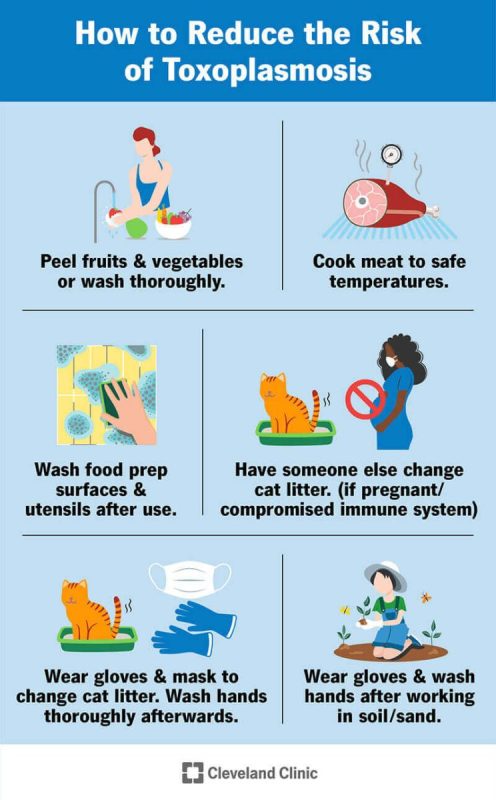
Toxoplasmosis in cats: ways of infection, symptoms, treatment and prevention
Toxoplasmosis is a common infectious disease caused by a protozoan parasite. Its primary host is a cat, and mammals, birds, and even humans can act as intermediate hosts. Such a disease is considered serious, so all measures must be taken to cure your beloved pet of toxoplasmosis and avoid the spread of infection.
Contents
What you need to know about toxoplasmosis
Parasites that cause toxoplasmosis in cats enter the body with meat. It can be raw lamb or pork, or small rodents. After infection, the causative agent of the disease, along with feces, enters the external environment, where infection of other animals, as well as birds and people, occurs. It is worth noting that the pathogen can get into the home with clothes and shoes. Accordingly, even those animals that are never outside are susceptible to this disease. It is worth noting that toxoplasmosis is not transmitted from one person to another.
Most often, toxoplasmosis affects cats under one year old and individuals who are 6 years old or more. This is due to an insufficiently strong immune system. The risk group also includes:
- animals fed raw meat;
- cats roaming freely on the street;
- sick animals and pets that have recently been ill;
- cats living in unfavorable conditions.
The parasite enters the cat’s body, and then moves to the small intestine, where cysts form. Toxoplasma begins to multiply directly in the cell, which dies as a result. formed in the intestines cysts come out with feces and become a source of infection for other animals and humans.
You can avoid infection if you immediately remove the feces. This is because Toxoplasma matures and poses a risk to people only a few days after exposure to the external environment. Its release is completed in an average of 2-3 weeks. Accordingly, the source of infection with toxoplasmosis is only the cat that became ill recently.
It is worth noting that Toxoplasma enters through the walls of the cat’s intestines into the spleen and hematopoietic organs, after which the parasite enters the bloodstream and spreads throughout the body, causing harm to all internal organs. If a cat has strong immunity, then over time, the reproduction and movement of the parasite stops or slows down noticeably. Accordingly, Toxoplasma remains in intracellular cysts, which are in the body for a long time. There are no outward symptoms.
It must be taken into account that toxoplasmosis is greatest danger to the developing fetus. If a pregnant woman becomes infected a few weeks before conception or in the first 3 months of pregnancy, then the death of the embryo, miscarriage, or the development of various pathologies is possible. If pets or a woman have been ill at least 6 months before conception, then the parasites “locked” in cysts will not harm the child.
Symptoms of toxoplasmosis
In most cases, the manifestation of toxoplasmosis in cats looks like a mild cold or a digestive disorder that does not last long. So, the first few days the animal is lethargic and refuses to eat. Moreover, diarrhea and vomiting are possible. When the cyst becomes passive, the manifestation of the disease is not observed. Sometimes there is a re-infection, which is asymptomatic. This is due to the fact that specific antibodies are formed in the cat’s blood.
Doctors allocate acute and subacute form of toxoplasmosis. In the latter case, there is a lack of appetite, lethargy, diarrhea, vomiting and purulent discharge from the eyes, as well as fever. If the parasite infects the respiratory system, symptoms such as coughing and sneezing, wheezing, heavy breathing, shortness of breath develop. Such signs resemble a common viral infection, so it is almost impossible to diagnose a cat on its own.
If the animal has very weak immunity, the development of an acute form will begin. Its symptoms resemble the subacute course of the disease, but the signs are much more pronounced. So, damage to the nervous system is possible, manifested by convulsions, fever and even paralysis. The death of cells of the spinal cord and brain is possible, due to which the foci of destruction are so large that the full functioning of the nervous system after recovery becomes impossible. It should be noted that a similar course of the disease is observed only in 7% of affected cats.
The prognosis depends only on the timeliness and correctness of the chosen treatment. If you do not turn to a specialist in time, then Toxoplasma will destroy the cells, which will lead to the formation of significant areas of necrosis. Accordingly, all internal organs will be significantly damaged, and this may result in the death of the pet.
Toxoplasmosis diagnosis and treatment
As mentioned earlier, cysts are released only a couple of weeks after infection, that is, before the onset of early signs. Accordingly, the study of cat feces was found to be ineffective. To confirm such a diagnosis, serological analysis of blood serum. You should also take a swab from the nose and throat.
After the diagnosis is made, it is necessary to adhere to all the recommendations of the doctor, because the use of traditional antiparasitic drugs will be ineffective.
In the presence of toxoplasmosis, a sick cat must isolated from children and other pets until the release of cysts into the environment stops. Doctors remind that toxoplasmosis is difficult to treat. This is because many drugs cannot reach Toxoplasma “locked” in cysts. In this case, the main task of treatment is to eliminate the symptoms of toxoplasmosis and stop the reproduction of the parasite. Accordingly, the drugs used transfer the disease from an acute form to a latent one.
The most commonly prescribed are spiramycin and sulfonamides. In addition, treatment involves the use of drugs aimed at strengthening the immune system, and vitamin complexes. With the defeat of some body systems, the use of appropriate medications is indicated.
If you take into account the recommendations of the veterinarian, then the improvement in the cat’s condition will be noticeable in a couple of days. Despite this, it is necessary complete the full course of treatment. After its completion, Toxoplasma in the cat’s body becomes inactive, and specific antibodies are formed in the blood. Accordingly, the cat becomes safe.
In some cases, re-development of toxoplasmosis is possible, caused by severe stress or diseases that weaken the immune system. In order to notice this in time, it is necessary to donate blood annually to determine the level of antibodies.
preventive measures
To avoid contracting feline toxoplasmosis and subsequently infecting other pets or family members, you must remember the precautions:
- the cat tray is cleaned daily, it is disinfected 2 times a week with an ammonia solution;
- when cleaning feces from the cat’s tray, gloves must be used;
- you need to ensure that the cat does not catch rodents and birds;
- raw meat is not suitable for feeding;
- the animal should drink only boiled water;
- it is necessary to regularly treat the pet from fleas;
- after contact with a cat, you should thoroughly wash your hands and face;
- meat is heat-treated before consumption;
- since toxoplasma is often found on fruits and vegetables, they should always be thoroughly washed;
- for cutting meat, you should purchase a separate board and knife;
- after contact with raw meat, wash your hands thoroughly;
- pregnant women are strictly forbidden to care for a cat.
Toxoplasmosis – serious illness, which can cause great harm to the body. For this reason, it is necessary to remember about preventive measures. If any unpleasant symptoms are found, the cat should be shown to the veterinarian and the necessary tests should be taken.





